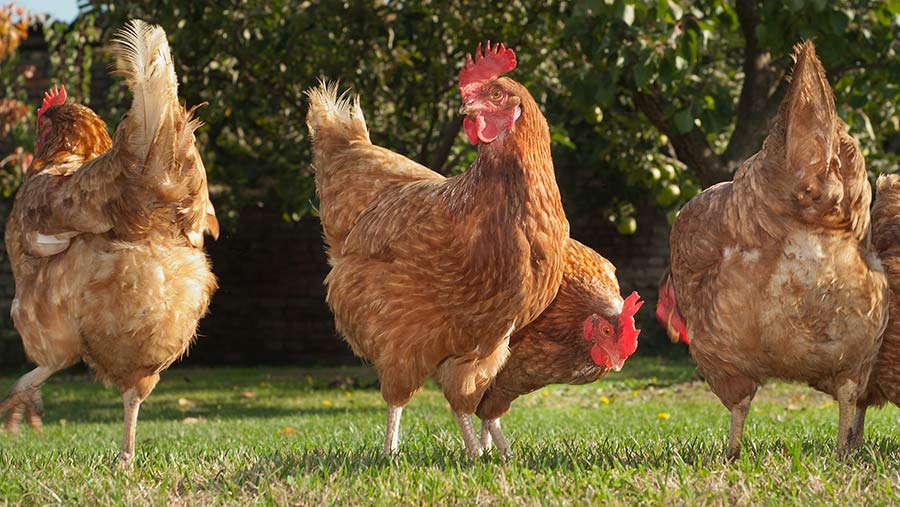How to plant trees to reduce poultry emissions and carbon
 © Dusan Kostic/Adobe Stock
© Dusan Kostic/Adobe Stock With trees featuring widely in new government farm support schemes, and with pressure on the poultry industry to reduce emissions, tree planting has become more important than ever for producers.
The role of trees in capturing carbon is well documented, but what is less known is that they have the potential to reduce nutrient loading, a factor with an important function on poultry units.
Concentrations of ammonia are at their highest levels close to the sheds, and those emissions are often associated with smell and dust which can affect the health of birds and workers.
Geraint Jones, forestry technical officer at Farming Connect, says tree planting can be very beneficial in this situation as linear woodland design can intercept ammonia emissions and particulates.
See also: How to calculate your poultry farm’s carbon footprint
“Creating tree belts downwind from emissions sources, such as poultry housing, can capture those emissions and particulates,” Mr Jones says.
Tree planting to capture ammonia can help to screen the emissions sources and buffer sensitive habitats.
Mr Jones gives guidance on how to incorporate trees in poultry ranges, and advice on which species work best, and where at a time.

Geraint Jones © Debbie James
Planting schemes
The trees closest to the sheds are the most important as they provide screening and soak up ammonia, but they will also be difficult to establish as they will be under greatest pressure from birds as they exit their housing.
To mitigate losses, plant at a higher density near the shed, graduating to a lower density further away, to provide more open space and encourage the birds to range.
Aim for a mix of native species that suit the unit’s soil and local climate conditions.
Where possible, make use of existing trees on the site by including these in the fenced areas.
Provided trees are well maintained, they should still achieve canopy closure within about five years, but local conditions will be variable.
Thinning is necessary once the canopies have started to close, as ranging birds favour dappled light areas among tree cover.
How trees improve flock welfare
As well as minimising a farm’s carbon footprint, trees have great benefits for the welfare of flocks.
There is good research linking high-quality tree canopy cover to reduced feather pecking and improved hen wellbeing.
Injurious feather pecking is an abnormal behaviour involving pulling, plucking and damaging the feathers of other birds. It is associated with higher mortality rates and disease levels,
Cath Price, poultry technical officer at Farming Connect, says: “In free-range systems this behaviour can be a particular problem because there are no restrictions on birds’ movements to prevent them from reaching potential victims.”
Previous studies had shown that greater use of outdoor space by birds, and incorporating trees, correlated with lower levels of plumage damage from pecking.
“The shelter and shade that a higher proportion of canopy cover provides encourages hens to range and this reduces feather pecking,” says Mrs Price.
Establishing tree cover can also provide economic benefits for poultry units.
“If the birds are happy they’ll produce more eggs,” says Mrs Price.
Tree species
Species choice will be determined by the farm’s soil, elevation and topography.
For planting near the shed, choose fast-growing species, such as white or grey poplar, fast-growing willows or hybrid varieties; although these are not native they will meet the overall objective.
If poplars are planted, remove these during subsequent thinning, when the wood becomes established, as this will allow room for the slower-growing native species to dominate.
This situation is unlikely to be achieved for at least 15 years, but could be sooner depending on the growth rate of the different species and the density of the planting.
If rapidly establishing canopy cover is a goal, aspen is a good choice, while the fastest-growing native species are birch, alder and willow.
To aid carbon capture and biodiversity, incorporate other native species, such as oak, silver birch, rowan, wild cherry and crab apple, as well as lower-storey shrub species such as hazel, hawthorn and elder.
Providing a wider range of species will also provide resilience against potential losses.
If there are particularly sensitive areas, such as at the base of ancient hedgerows, it is worth fencing these off to protect them from scratching by the birds.
Spacing
Spacing requirements will vary from species to species, but to qualify for the premium paid for eggs marketed as “woodland produced”, a minimum requirement of 20% tree cover is needed on the total area of land designated for birds to range on.
For uniform and easy-to-manage lines, plant at regular 2m, 2.5m or 3m spacing, ideally with a gap of 2-3m between rows.
Planting at this density will require future thinning when the canopy closes but will become “woodland” faster and could provide an early source of firewood.
Planting in rows makes management with tractor-mounted machinery possible – avoid planting in grids and plant on a linear curve to create a wavy edge.
This design will provide greater shelter from different wind directions and produce a more aesthetic landscape.
Alternatively, plant small groups of trees at irregular spacing of 2-3m, leaving larger spaces between the groups for the birds to roam through.
Weed control
The planting design needs to accommodate mechanical weeding or mowing the grass between rows.
To achieve this, consider the width of the tractor and topper or mower, and allow sufficient space between rows with room at the end of the rows for tractors to turn.
Planting at wider spacing, perhaps 4-5m, will allow for the tractor mowing between rows. Trees can then be spaced 2-3m apart within the rows.
Adding shrubs
Putting shrubs on the edges of the planting areas will create a graded woodland edge, which encourages birds to explore; it will also act as a windbreak, making the area warmer, and improves screening of the sheds.
Avoid allowing the lower branches of the shrubs to come into contact with ground vegetation such as grasses, as this level of cover can encourage hens to lay outside in the enclosed areas under shrubs.
Keep the stems clean and high prune the lower branches to allow light to reach the ground.
Keep the understorey clean; there are specialist mowers available with a mobile flail head as an extension to the topper itself that can flail directly up to the tree stem and around the base without damaging the bark.
Protecting trees from birds
Hens can damage trees by pecking the leaders that emerge from the tree guards, but selecting saplings at a minimum of 60cm and up to 90cm, placed in 70cm tubes, will minimise this risk and deter the hens from reaching the plant leaders.
Maintenance
Keep vegetation short and stick to a system of regular strimming or topping.
Don’t be tempted to graze the range with sheep as this will decimate the growing trees.
Regarding issues with compaction, the trees will address this themselves because their root network provides a natural drainage network and they will take advantage of the porosity of the soil to absorb surface water flow.
Tree planting grants
There is a host of standalone grant schemes and stewardship options available across the UK regions.
These provide a wide range of advice and financial support covering planting, protecting and managing trees.
Advice on finding the most suitable scheme is available through Woodland Trust.
England
- Woodland Creation Planning Grant
- England Woodland Creation Offer
- Woodland Carbon Code
- Woodland Carbon Guarantee
- Woodland Management Planning Grant
- Woodland Creation and Maintenance
- Woodland Tree Health
- Woodland Improvement
gov.uk/government/collections/tree-planting-and-woodland-creation-funding-and-advice
Northern Ireland
- Small Woodland grant scheme
- Woodland Investment Grant
- Forest Expansion Scheme
daera-ni.gov.uk/publications/small-woodland-grant-scheme-information-booklet
Scotland
- Forestry Grant Scheme
- Future Woodland Fund
- MOREWoods
- Small Tree Planting Grant
forestry.gov.scot/support-regulations/forestry-grants
Wales
- Woodland Creation Grants
- Woodland Creation Planning Scheme
- The Woodland Investment Grant
- Woodland Restoration Scheme
